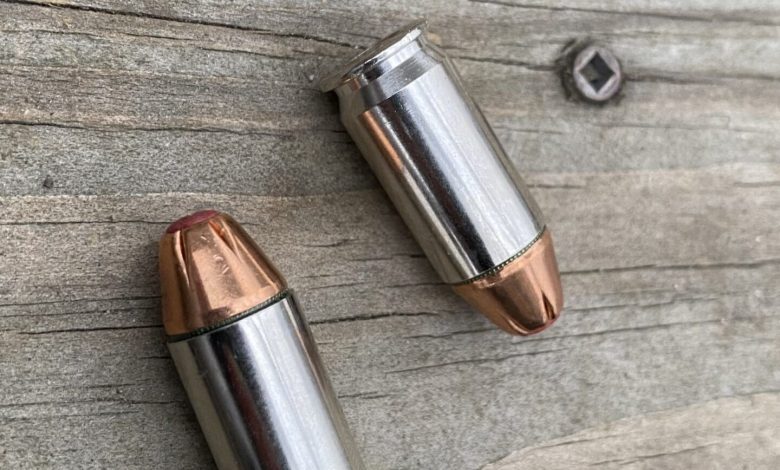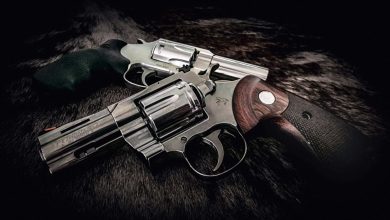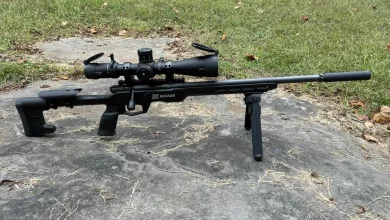The Debate That Seems To Never End

It’s one of the most heated rivalries in the firearms world: 9mm vs. .45 ACP.
You’ll find passionate shooters on both sides, each armed with their reasons, stats and stories to defend their favorite round.
But what makes these calibers so iconic? Why do they both continue to thrive, despite changing trends and tech?
In this fun breakdown, we’re diving deep into the roots of these legendary rounds, exploring their pros and cons and seeing how modern advancements have kept them both as top contenders for todays shooters.
We’re going to keep this article short and sweet and not bore you with a long, drawn-out history lesson.
The Origins of 9mm and .45 ACP: A Battle Born in History
Before we jump into this debate head first, let’s take a quick journey back to where it all began.
The 9mm Parabellum, created by the legendary Georg Luger in 1902, was initially designed to arm European militaries with a faster, lighter round. Known for its reliability and ease of use, the 9mm quickly gained popularity.
Across the Atlantic, however, the U.S. was facing a different challenge. In the early 1900s, after the Moro Rebellion in the Philippines, the U.S. military realized it’s current handgun round wasn’t providing enough stopping power in close combat.
Enter John Browning’s .45 ACP (Automatic Colt Pistol), officially adopted in 1911. This larger, slower round packed a heavier punch, which became an immediate favorite for American soldiers and police forces looking for more power.
From their origins, the 9mm and .45 ACP served different purposes. Both calibers have evolved in surprising ways to stay relevant today.
9mm vs. .45 ACP: Speed vs. Stopping Power
Now that we know the backstory, let’s break down what makes these calibers so unique.
The 9mm is renowned for its higher velocity, generally achieving around 1,200 feet per second. This speed translates to a flatter trajectory and easier control, which appeals to most shooters. Plus, the 9mm allows you to carry more rounds in a magazine.
On the other hand, the .45 ACP is all about stopping power. Traveling at a slower speed, usually around 850 feet per second, the .45’s power lies in its weight and diameter. It hits much harder with more energy on target. With this increased power, comes more recoil too.
Many enthusiasts argue this is better for stopping a threat with a single shot, but then again, who fires only one round when their life is on the line?
So, what’s the trade-off? With the 9mm, you get better recoil control and capacity, but with the .45 ACP, you get sheer stopping power. Both calibers have pros and cons, making the decision a matter of personal preference.
Modern Innovations: Keeping 9mm and .45 ACP in the Game
While the classic 9mm vs. .45 ACP debate remains, recent advancements have breathed new life into both calibers, keeping them competitive and popular among shooters worldwide.
Innovations in bullet technology and powder efficiency have significantly boosted the 9mm’s performance. Modern 9mm ammunition offers impressive expansion and penetration, often rivaling the stopping power of larger calibers.
This has led to a resurgence of the 9mm in law enforcement agencies and military units, as improvements have made it an even more versatile round for personal and professional defense. Plus, 9mm ammunition is typically more affordable, making it a popular choice for practice and training.
The .45 ACP hasn’t been left behind, though. Advances in hollow-point and bonded-core technology have also enhanced its penetration and expansion.
Although the .45 ACP’s magazine capacity may never match the 9mm, modern firearms manufacturers are manufacturing .45 ACP pistols that maximize round count, giving shooters more options than ever. These improvements mean that, despite its age, the .45 ACP remains a powerful contender for those who prefer a heavier punch.
In short, modern innovations have worked wonders for both calibers. Today, choosing between 9mm and .45 ACP doesn’t mean compromising on performance but rather deciding which updated features best fit your needs.
I put the following question out to my group on LinkedIn which consists of local law enforcement, federal agencies, military and executive protection professionals.
Here was some of that feedback.
I shoot major with my custom .45 super just because of badassery. However, I carry 9mm due to higher round carrying capacity and most high quality frangible 9mm gives close to the stopping power of a .45. Still, nothing beats sending ashtrays down range! – Allen D.
For me it comes down to purpose. Both are phenomenal rounds and when fired from capable platforms deliver expected performance. But what is the purpose in which would use either round? That is the question. All others are just derivatives of this. – Jason M.
Training, practice, and proficiency is most important regardless of personal preference. That said, I’m partial to my HK45. Why? DA/SA, accuracy, decent suppression – personal preference. – Darryl W.
Oh the great caliber debate. Both have their own distinct advantages and considerations. I personally would choose my SIG SAUER, Inc. P365 chambered in 9mm, however 😎 .45 tends to have too much recoil for my small hands. – Megan O.
As a 23 year Army infantry veteran with extensive experience with both it’s really about preference. However. If I had zero choice and had to take a rd to the chest I would prefer to get hit with the 9MM than the .45 as the chance to survive is higher. So, if I’m using the weapon for protection I would choose the .45. Some will argue not as accurate due to higher recoil but I would say go practice more. I own both. I have a SIG P229 Legion 9MM and a Wilson Combat X Tac Supergrade .45 that I sleep with. Probably would not want to be on the bad end of either. – Kevin G.
9mm vs. .45 ACP: Which is Right for You?
So, after all the history, technical breakdowns and innovations, which caliber comes out on top? The answer, unsurprisingly, depends on your specific needs and preferences.
For those who prioritize capacity, recoil control and affordability, the 9mm remains an excellent choice. Its lighter recoil and higher round count give it a clear edge in situations where fast follow-up shots and extended shooting sessions matter. Many newer shooters find the 9mm’s recoil more manageable, making it ideal for training and building confidence.
On the other hand, the .45 ACP is the go-to for shooters who value stopping power and prefer a round with a bit more “authority.” While it may be slower and heavier, it delivers impressive terminal ballistics that fans argue make it the ultimate choice for personal defense. If you’re looking for a caliber with serious impact, the .45 ACP is hard to beat.
In the end, the 9mm vs. .45 ACP debate is less about one being “better” and more about finding the right fit for your shooting style. Both calibers have earned their legendary status, proving that a century-old rivalry can still thrive in the modern shooting world. So, whether you lean toward the speed and precision of the 9mm or the raw power of the .45 ACP, you’re in good company. After all, some debates just get better with age.
Read the full article here






